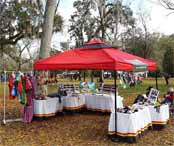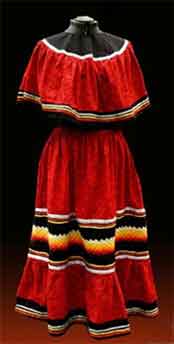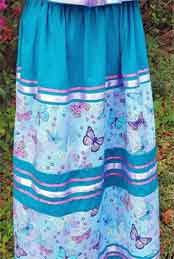 Look for our booth at Georgia and North Florida Native American events.
Our Artists |
About Creek IndiansBeginning with the earliest written records of trips through what is now north Florida, Georgia, Alabama, and parts of the Carolinas, you will find the same names of Native American towns until the great removal, or Trail of Tears, during 1830-1850. During this 300 year period (1500s-1800s), northern Indian towns were gradually pushed further south and west. Most Indians in this geographic area belonged to the Cherokee, Chickasaw, Choctaw, Creek, and Seminole – all members of the Five Civilized Tribes – a loose confederacy of Indian tribes. These groups adopted many of the colonists' customs and had good relations with their neighbors. The Chickasaw, Choctaw and Creeks shared a common root language called “Muskhogean.” They also built their towns along the banks of rivers or “creeks” and were referred to as the Indians “who lived along the creek” – which is how they got their name. They were farmers and their towns had existed in the same location for hundreds of years. They were not nomadic like the western or plains Indians. Each year they grew and harvested crops of corn, squash, and beans. They celebrated the planting of their crops in Spring, first harvest, and last harvest. They wore clothing made of woven plant materials or animal skins prior to the influence of European products in the late 1600s. Woven fabrics quickly became popular along the trade routes and their clothing adopted a bright and colorful style all their own. Turbans were popular head coverings for men and shawls and aprons became popular for women. They developed a unique patchwork design technique that can be seen on traditional regalia worn at Pow Wows today. Around 1775 the Creek population is estimated to have been about 20,000, occupying from 40 to 60 towns. After Tecumseh, a Shawnee leader, visited the Five Civilized Tribes during 1811-12, they became divided into the Upper Creeks (Red-Sticks or non-friendly Indians to the west) and Lower Creeks (white towns, or friendly Indians to the east in present day Georgia). The Creek Indian Wars (also called Seminole Indian Wars) began shortly after Tecumseh’s visit and continued through 1814. By 1830, Indian removal escalated and thousands of Indians were marched to Oklahoma – now called the “Trail of Tears”. The sparsely populated areas of Florida, south Georgia and Alabama were ideal areas for Indians to hide. Therefore, removing Indians in the Florida, Georgia and Alabama areas continued until the Civil War began in 1861. Research published in the early 1900s places the following groups (or towns) together based upon similarities in their spoken language: Northern Branch
Southern Branch
Others with similar language
Tribal affiliations changed – especially during the years when Indians were loosing their tribal land and being forced to move into areas “owned” by other tribes. Remnants of one tribe would be absorbed by another. Some tribal members adopted the ways of the settlers and tried to remain on their home lands, passing themselves off as settlers. Others hid in the woods. Many stories have been handed down of Indian parents leaving their children in the hands of their white neighbors before they were captured and made to walk the Trail of Tears to the reservations in Oklahoma. Today, the tribes listed above are generally accepted as belonging to the same linguistic group and collectively known as the Creek Confederacy which was part of the Five Civilized Tribes. The Apalachee, Hitichiti, Tuskegee, and Muskogee are the primary groups considered to be “Creek” Indians. The Seminoles – which means “run away,” were formed in the late 1700s when members of the above towns ran south to escape the white man and later the Trail of Tears. They banded together to form a new alliance south of the Suwannee River in Florida. Indians remaining in the North Florida, Alabama, and Georgia areas after the Trail of Tears, did so at great risks to themselves and their families. Money was freely paid to anyone who brought in an Indian – dead or alive. The children of these families were forbidden to follow tribal customs, speak their native language, or do anything that would identify them as Indians. However, many managed to secretly keep their culture alive and pass it down to the younger generations. Today, the North Florida, Alabama, and Georgia areas have many state or federally recognized tribes as well as many who are not officially recognized. Here are some of these tribes: Alabama Creek Tribes
Georgia Creek Tribes
North Florida Creek Tribes
|



